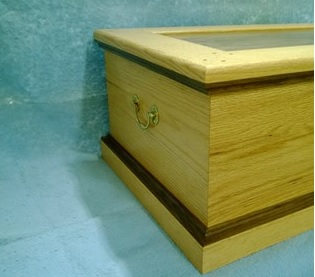I was contacted by an old racing buddy in regards to his wishes to have a hope chest built for a young lady who was a girlfriend of his son. He was aware of my woodworking and in fact, had purchased some picture frames from me in the past. When he hit me up about the project, I had some free time open and told him that I was willing to get right on it. He drew up some plans and emailed them to me and after a little bit of communication back and forth between us in relation to the design...I set upon building it.

The picture frames that I had fabricated and provided to him were a combination of red oak and walnut...(one of my favorite combinations) and he liked that look and wanted the same look with the chest. A simple, straightforward project in design....it did provide me with a new concept that I had never incorporated into any past projects. He wanted reinforcing splines in the 45 degree corners of the chest. I was intrigued and welcomed the new challenge.

I used walnut as the upper and lower trim of the box, as well as the panel insert in the lid. Walnut was also used as the "floor" of the box and the cleats that supports the movable tray inside and the bottom of that same tray. The splines in the box, the bottom oak trim and the oak tray were all walnut also. As a finishing touch, I also added four decorative walnut dowels in each corner of the lid.

